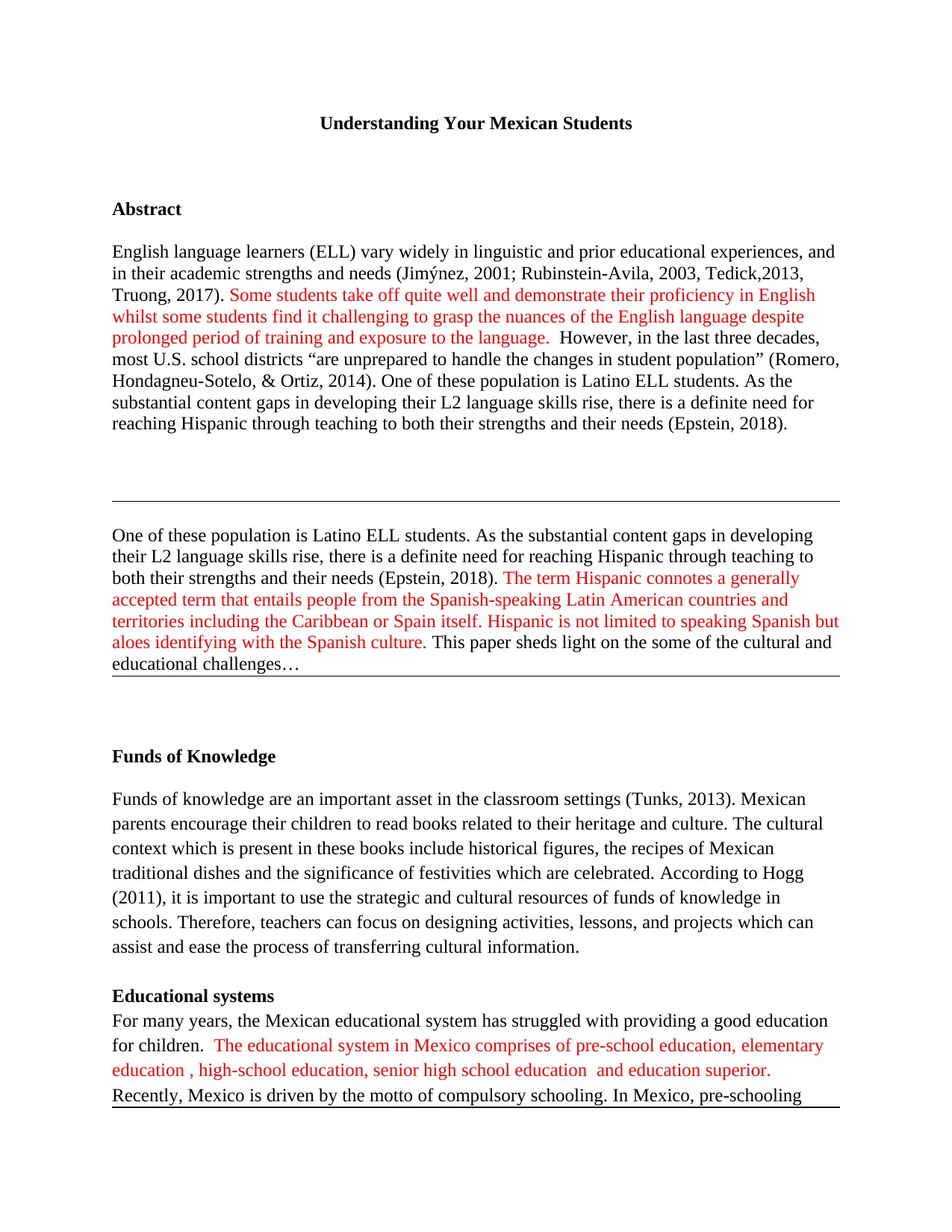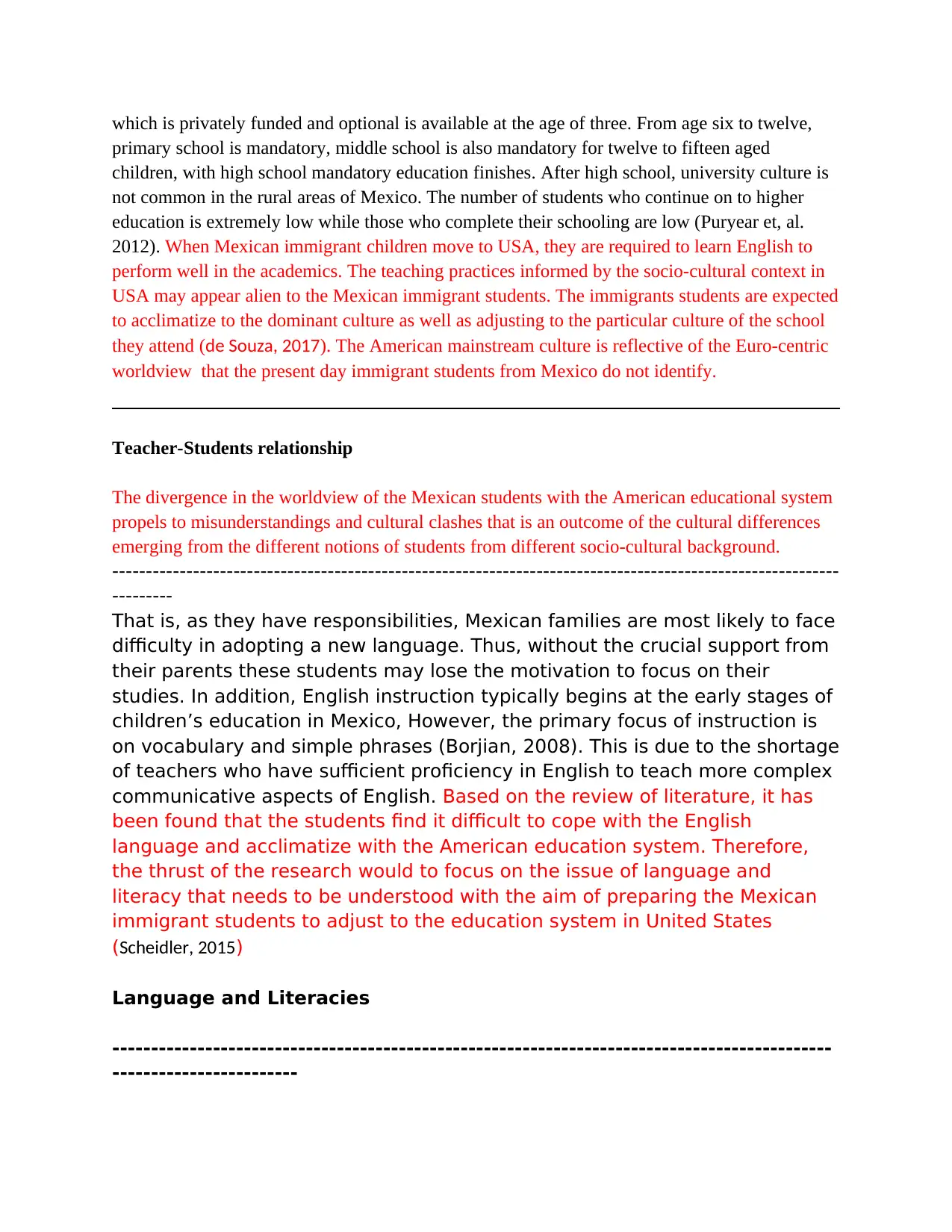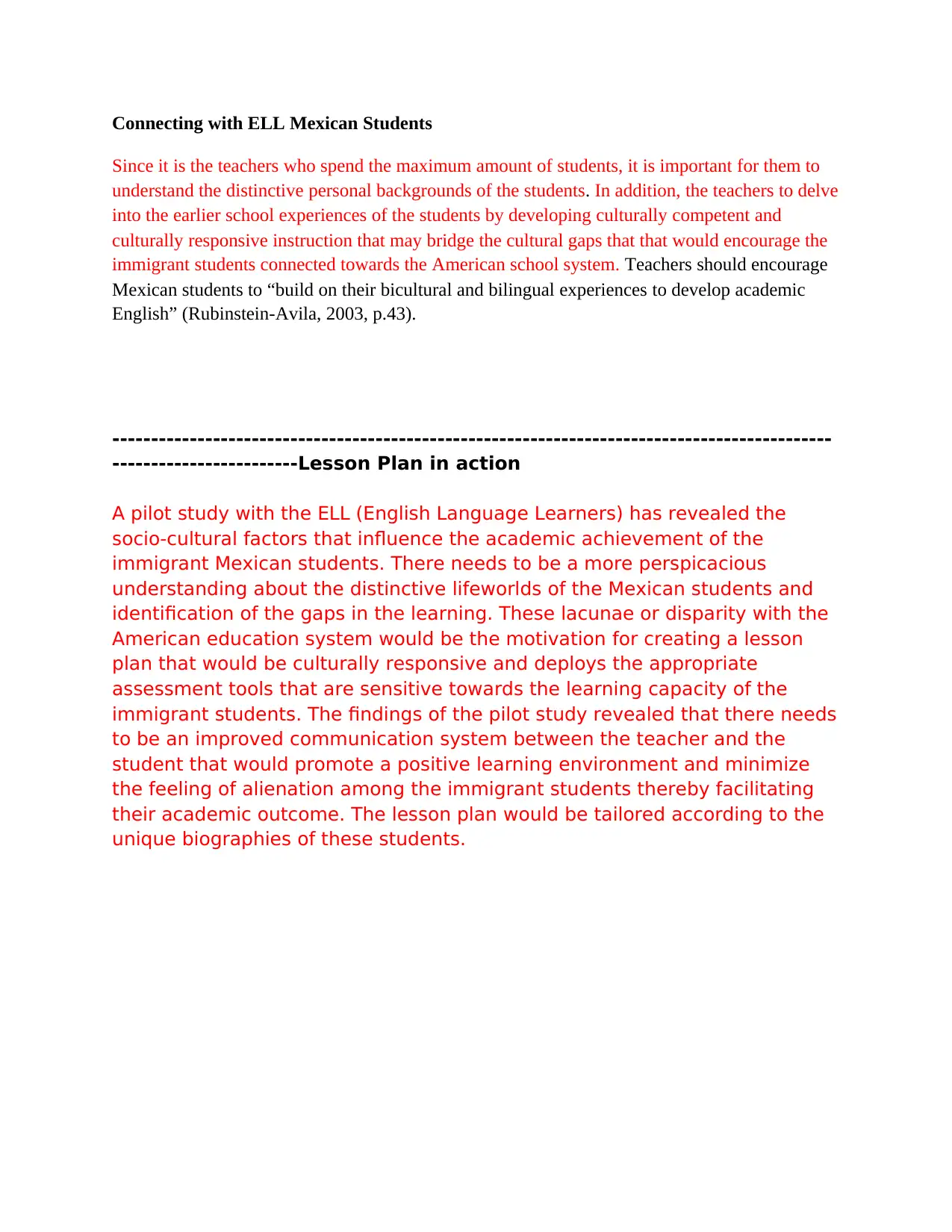Addressing Language & Literacy for Mexican Students in the USA
VerifiedAdded on 2023/06/11
|4
|1344
|61
Essay
AI Summary
This essay explores the cultural and educational challenges faced by Mexican English Language Learners (ELLs) in the United States. It highlights the importance of understanding their linguistic backgrounds, prior educational experiences, and the role of 'funds of knowledge' in their learning process. The essay discusses the differences between the Mexican and American education systems, the impact of cultural divergence on teacher-student relationships, and the need for culturally responsive teaching practices. It emphasizes the significance of addressing language and literacy gaps, building on students' bicultural experiences, and fostering improved communication between teachers and students to create a positive learning environment and enhance academic outcomes for Mexican immigrant students. The essay also mentions a pilot study and lesson plan designed to bridge cultural gaps and promote academic success. Desklib provides access to similar essays and resources for students.

Understanding Your Mexican Students
Abstract
English language learners (ELL) vary widely in linguistic and prior educational experiences, and
in their academic strengths and needs (Jimýnez, 2001; Rubinstein-Avila, 2003, Tedick,2013,
Truong, 2017). Some students take off quite well and demonstrate their proficiency in English
whilst some students find it challenging to grasp the nuances of the English language despite
prolonged period of training and exposure to the language. However, in the last three decades,
most U.S. school districts “are unprepared to handle the changes in student population” (Romero,
Hondagneu-Sotelo, & Ortiz, 2014). One of these population is Latino ELL students. As the
substantial content gaps in developing their L2 language skills rise, there is a definite need for
reaching Hispanic through teaching to both their strengths and their needs (Epstein, 2018).
One of these population is Latino ELL students. As the substantial content gaps in developing
their L2 language skills rise, there is a definite need for reaching Hispanic through teaching to
both their strengths and their needs (Epstein, 2018). The term Hispanic connotes a generally
accepted term that entails people from the Spanish-speaking Latin American countries and
territories including the Caribbean or Spain itself. Hispanic is not limited to speaking Spanish but
aloes identifying with the Spanish culture. This paper sheds light on the some of the cultural and
educational challenges…
Funds of Knowledge
Funds of knowledge are an important asset in the classroom settings (Tunks, 2013). Mexican
parents encourage their children to read books related to their heritage and culture. The cultural
context which is present in these books include historical figures, the recipes of Mexican
traditional dishes and the significance of festivities which are celebrated. According to Hogg
(2011), it is important to use the strategic and cultural resources of funds of knowledge in
schools. Therefore, teachers can focus on designing activities, lessons, and projects which can
assist and ease the process of transferring cultural information.
Educational systems
For many years, the Mexican educational system has struggled with providing a good education
for children. The educational system in Mexico comprises of pre-school education, elementary
education , high-school education, senior high school education and education superior.
Recently, Mexico is driven by the motto of compulsory schooling. In Mexico, pre-schooling
Abstract
English language learners (ELL) vary widely in linguistic and prior educational experiences, and
in their academic strengths and needs (Jimýnez, 2001; Rubinstein-Avila, 2003, Tedick,2013,
Truong, 2017). Some students take off quite well and demonstrate their proficiency in English
whilst some students find it challenging to grasp the nuances of the English language despite
prolonged period of training and exposure to the language. However, in the last three decades,
most U.S. school districts “are unprepared to handle the changes in student population” (Romero,
Hondagneu-Sotelo, & Ortiz, 2014). One of these population is Latino ELL students. As the
substantial content gaps in developing their L2 language skills rise, there is a definite need for
reaching Hispanic through teaching to both their strengths and their needs (Epstein, 2018).
One of these population is Latino ELL students. As the substantial content gaps in developing
their L2 language skills rise, there is a definite need for reaching Hispanic through teaching to
both their strengths and their needs (Epstein, 2018). The term Hispanic connotes a generally
accepted term that entails people from the Spanish-speaking Latin American countries and
territories including the Caribbean or Spain itself. Hispanic is not limited to speaking Spanish but
aloes identifying with the Spanish culture. This paper sheds light on the some of the cultural and
educational challenges…
Funds of Knowledge
Funds of knowledge are an important asset in the classroom settings (Tunks, 2013). Mexican
parents encourage their children to read books related to their heritage and culture. The cultural
context which is present in these books include historical figures, the recipes of Mexican
traditional dishes and the significance of festivities which are celebrated. According to Hogg
(2011), it is important to use the strategic and cultural resources of funds of knowledge in
schools. Therefore, teachers can focus on designing activities, lessons, and projects which can
assist and ease the process of transferring cultural information.
Educational systems
For many years, the Mexican educational system has struggled with providing a good education
for children. The educational system in Mexico comprises of pre-school education, elementary
education , high-school education, senior high school education and education superior.
Recently, Mexico is driven by the motto of compulsory schooling. In Mexico, pre-schooling
Paraphrase This Document
Need a fresh take? Get an instant paraphrase of this document with our AI Paraphraser

which is privately funded and optional is available at the age of three. From age six to twelve,
primary school is mandatory, middle school is also mandatory for twelve to fifteen aged
children, with high school mandatory education finishes. After high school, university culture is
not common in the rural areas of Mexico. The number of students who continue on to higher
education is extremely low while those who complete their schooling are low (Puryear et, al.
2012). When Mexican immigrant children move to USA, they are required to learn English to
perform well in the academics. The teaching practices informed by the socio-cultural context in
USA may appear alien to the Mexican immigrant students. The immigrants students are expected
to acclimatize to the dominant culture as well as adjusting to the particular culture of the school
they attend (de Souza, 2017). The American mainstream culture is reflective of the Euro-centric
worldview that the present day immigrant students from Mexico do not identify.
Teacher-Students relationship
The divergence in the worldview of the Mexican students with the American educational system
propels to misunderstandings and cultural clashes that is an outcome of the cultural differences
emerging from the different notions of students from different socio-cultural background.
------------------------------------------------------------------------------------------------------------
---------
That is, as they have responsibilities, Mexican families are most likely to face
difficulty in adopting a new language. Thus, without the crucial support from
their parents these students may lose the motivation to focus on their
studies. In addition, English instruction typically begins at the early stages of
children’s education in Mexico, However, the primary focus of instruction is
on vocabulary and simple phrases (Borjian, 2008). This is due to the shortage
of teachers who have sufficient proficiency in English to teach more complex
communicative aspects of English. Based on the review of literature, it has
been found that the students find it difficult to cope with the English
language and acclimatize with the American education system. Therefore,
the thrust of the research would to focus on the issue of language and
literacy that needs to be understood with the aim of preparing the Mexican
immigrant students to adjust to the education system in United States
(Scheidler, 2015)
Language and Literacies
---------------------------------------------------------------------------------------------
------------------------
primary school is mandatory, middle school is also mandatory for twelve to fifteen aged
children, with high school mandatory education finishes. After high school, university culture is
not common in the rural areas of Mexico. The number of students who continue on to higher
education is extremely low while those who complete their schooling are low (Puryear et, al.
2012). When Mexican immigrant children move to USA, they are required to learn English to
perform well in the academics. The teaching practices informed by the socio-cultural context in
USA may appear alien to the Mexican immigrant students. The immigrants students are expected
to acclimatize to the dominant culture as well as adjusting to the particular culture of the school
they attend (de Souza, 2017). The American mainstream culture is reflective of the Euro-centric
worldview that the present day immigrant students from Mexico do not identify.
Teacher-Students relationship
The divergence in the worldview of the Mexican students with the American educational system
propels to misunderstandings and cultural clashes that is an outcome of the cultural differences
emerging from the different notions of students from different socio-cultural background.
------------------------------------------------------------------------------------------------------------
---------
That is, as they have responsibilities, Mexican families are most likely to face
difficulty in adopting a new language. Thus, without the crucial support from
their parents these students may lose the motivation to focus on their
studies. In addition, English instruction typically begins at the early stages of
children’s education in Mexico, However, the primary focus of instruction is
on vocabulary and simple phrases (Borjian, 2008). This is due to the shortage
of teachers who have sufficient proficiency in English to teach more complex
communicative aspects of English. Based on the review of literature, it has
been found that the students find it difficult to cope with the English
language and acclimatize with the American education system. Therefore,
the thrust of the research would to focus on the issue of language and
literacy that needs to be understood with the aim of preparing the Mexican
immigrant students to adjust to the education system in United States
(Scheidler, 2015)
Language and Literacies
---------------------------------------------------------------------------------------------
------------------------

Connecting with ELL Mexican Students
Since it is the teachers who spend the maximum amount of students, it is important for them to
understand the distinctive personal backgrounds of the students. In addition, the teachers to delve
into the earlier school experiences of the students by developing culturally competent and
culturally responsive instruction that may bridge the cultural gaps that that would encourage the
immigrant students connected towards the American school system. Teachers should encourage
Mexican students to “build on their bicultural and bilingual experiences to develop academic
English” (Rubinstein-Avila, 2003, p.43).
---------------------------------------------------------------------------------------------
------------------------Lesson Plan in action
A pilot study with the ELL (English Language Learners) has revealed the
socio-cultural factors that influence the academic achievement of the
immigrant Mexican students. There needs to be a more perspicacious
understanding about the distinctive lifeworlds of the Mexican students and
identification of the gaps in the learning. These lacunae or disparity with the
American education system would be the motivation for creating a lesson
plan that would be culturally responsive and deploys the appropriate
assessment tools that are sensitive towards the learning capacity of the
immigrant students. The findings of the pilot study revealed that there needs
to be an improved communication system between the teacher and the
student that would promote a positive learning environment and minimize
the feeling of alienation among the immigrant students thereby facilitating
their academic outcome. The lesson plan would be tailored according to the
unique biographies of these students.
Since it is the teachers who spend the maximum amount of students, it is important for them to
understand the distinctive personal backgrounds of the students. In addition, the teachers to delve
into the earlier school experiences of the students by developing culturally competent and
culturally responsive instruction that may bridge the cultural gaps that that would encourage the
immigrant students connected towards the American school system. Teachers should encourage
Mexican students to “build on their bicultural and bilingual experiences to develop academic
English” (Rubinstein-Avila, 2003, p.43).
---------------------------------------------------------------------------------------------
------------------------Lesson Plan in action
A pilot study with the ELL (English Language Learners) has revealed the
socio-cultural factors that influence the academic achievement of the
immigrant Mexican students. There needs to be a more perspicacious
understanding about the distinctive lifeworlds of the Mexican students and
identification of the gaps in the learning. These lacunae or disparity with the
American education system would be the motivation for creating a lesson
plan that would be culturally responsive and deploys the appropriate
assessment tools that are sensitive towards the learning capacity of the
immigrant students. The findings of the pilot study revealed that there needs
to be an improved communication system between the teacher and the
student that would promote a positive learning environment and minimize
the feeling of alienation among the immigrant students thereby facilitating
their academic outcome. The lesson plan would be tailored according to the
unique biographies of these students.
⊘ This is a preview!⊘
Do you want full access?
Subscribe today to unlock all pages.

Trusted by 1+ million students worldwide

References
de Souza, M. (2017). Understanding Mexican immigrant students in American schools: A case
study of two Preparatorias in México. Cogent Education, 4(1), 1387963.
Scheidler, J. M. (2015). Strategies for teaching Mexican American English language learners in
the USA: a literature review. International Journal of Teaching and Case Studies,6(1), 1-
19.
de Souza, M. (2017). Understanding Mexican immigrant students in American schools: A case
study of two Preparatorias in México. Cogent Education, 4(1), 1387963.
Scheidler, J. M. (2015). Strategies for teaching Mexican American English language learners in
the USA: a literature review. International Journal of Teaching and Case Studies,6(1), 1-
19.
1 out of 4
Your All-in-One AI-Powered Toolkit for Academic Success.
+13062052269
info@desklib.com
Available 24*7 on WhatsApp / Email
![[object Object]](/_next/static/media/star-bottom.7253800d.svg)
Unlock your academic potential
Copyright © 2020–2025 A2Z Services. All Rights Reserved. Developed and managed by ZUCOL.

